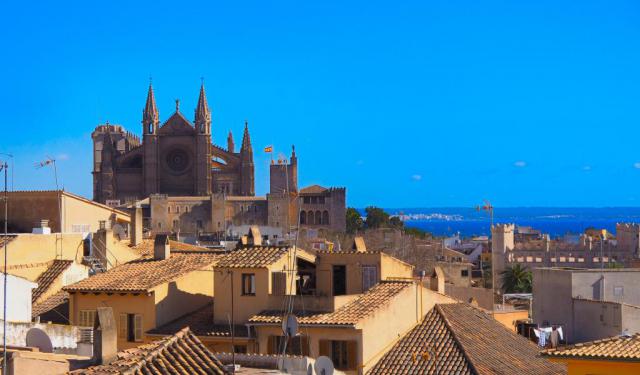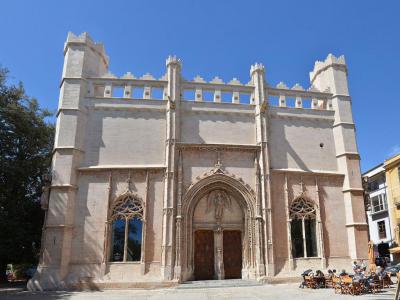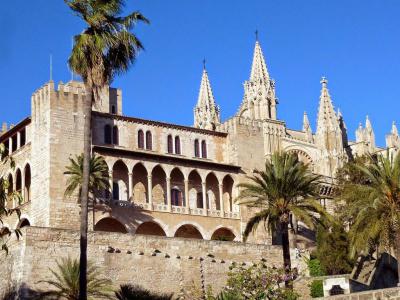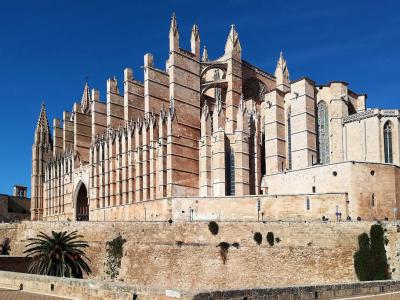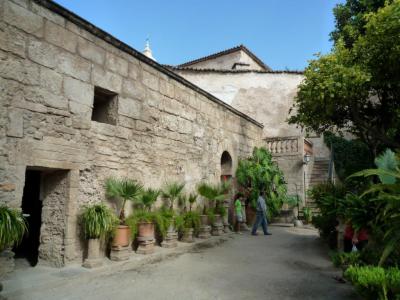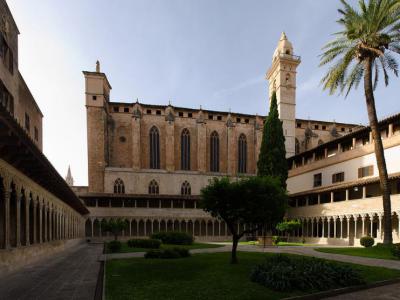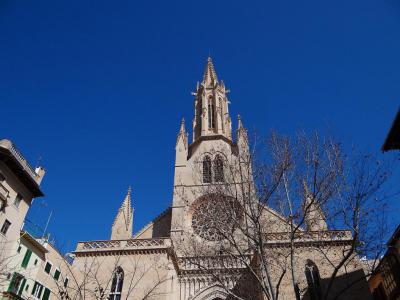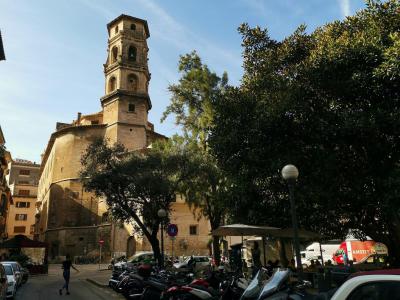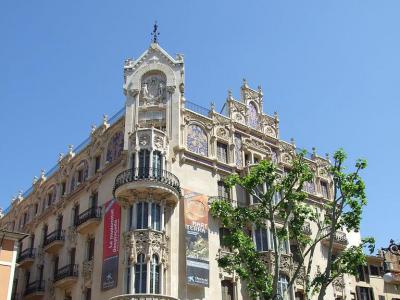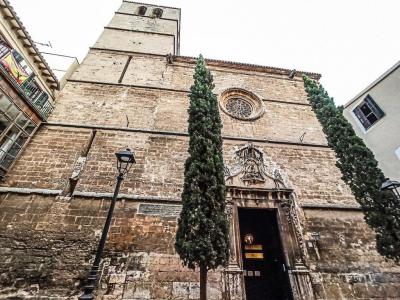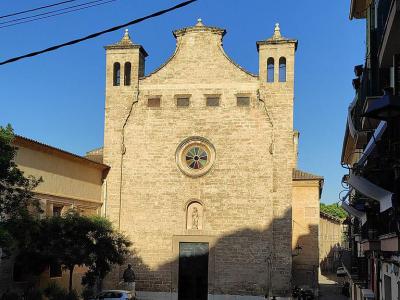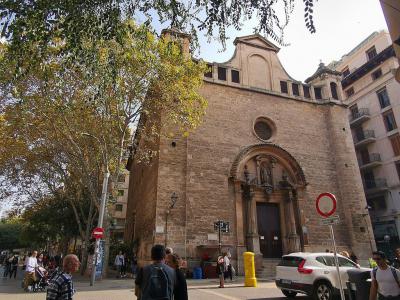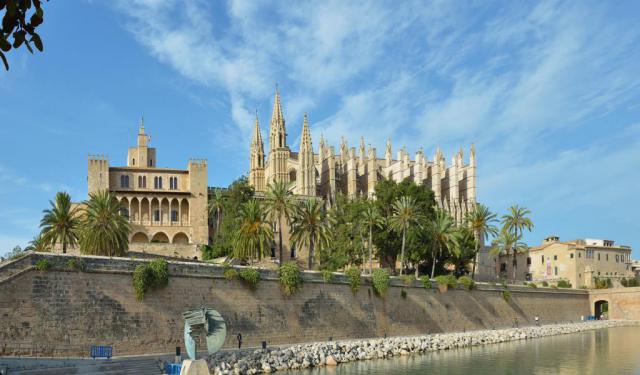Historical Buildings Walking Tour (Self Guided), Palma de Mallorca
Fervent devotees of the past will undoubtedly find Palma de Mallorca's old town quite alluring for a chance to get closer to the island's culture and discover firsthand the unspoiled Mallorca as it once was. Indeed, the historic center of the city is ideal for an acquaintance with the local heritage richly presented in the form of multiple historic buildings.
Some of them, like the medieval churches of Sant Nicolau, Sant Jaume, Santa Magdalena or Santa Catalina de Sena, are tucked away in the maze of quaint, narrow streets, while others, like the Palma Cathedral, also known as “La Seu”, an absolute must-see Gothic masterpiece, dominate the seafront (Paseo Marítimo). Each of these unique edifices is an epochal monument in its own right and can easily transport you back in time to experience how the people of Mallorca lived, worked and prayed centuries ago.
Amid the countless local castles, palaces, monasteries and churches to cast your eyes on, there are some truly not to miss ones, including:
La Llotja (The Market) – a cool piece of bourgeois Gothic architecture; constructed in the 1420s-40s;
Royal Palace of La Almudaina – a 14th-century "alcazar" fortress and the official summer residence of the Spanish Royal Family;
Banys àrabs (Arab Baths) – the trace of Muslim rule in what once was Medina Mayurka; dating possibly from the 10th century.
Convent of San Francisco – built in 1232, one of the best examples of medieval architecture in Palma de Mallorca;
Church of Santa Eulalia – a fabulous 13th-century place of worship, dedicated to the patron-saint of Barcelona;
Ayuntamiento (Town Hall) – a three-story building with a Baroque style facade, cheek and jowl with the Palace of the Council of Mallorca;
Gran Hotel – a modernist former hotel, built in 1903, designed by Master architect Lluis Domenech i Montaner.
Palma is a city that can be easily explored on foot. Its streets invite you to lose yourself and wander around on a gentle stroll, taking in the history, whether in company or alone, in an unhurried way. Just start exploring and allow yourself to be carried away with the help of our self-guided walking tour.
Some of them, like the medieval churches of Sant Nicolau, Sant Jaume, Santa Magdalena or Santa Catalina de Sena, are tucked away in the maze of quaint, narrow streets, while others, like the Palma Cathedral, also known as “La Seu”, an absolute must-see Gothic masterpiece, dominate the seafront (Paseo Marítimo). Each of these unique edifices is an epochal monument in its own right and can easily transport you back in time to experience how the people of Mallorca lived, worked and prayed centuries ago.
Amid the countless local castles, palaces, monasteries and churches to cast your eyes on, there are some truly not to miss ones, including:
La Llotja (The Market) – a cool piece of bourgeois Gothic architecture; constructed in the 1420s-40s;
Royal Palace of La Almudaina – a 14th-century "alcazar" fortress and the official summer residence of the Spanish Royal Family;
Banys àrabs (Arab Baths) – the trace of Muslim rule in what once was Medina Mayurka; dating possibly from the 10th century.
Convent of San Francisco – built in 1232, one of the best examples of medieval architecture in Palma de Mallorca;
Church of Santa Eulalia – a fabulous 13th-century place of worship, dedicated to the patron-saint of Barcelona;
Ayuntamiento (Town Hall) – a three-story building with a Baroque style facade, cheek and jowl with the Palace of the Council of Mallorca;
Gran Hotel – a modernist former hotel, built in 1903, designed by Master architect Lluis Domenech i Montaner.
Palma is a city that can be easily explored on foot. Its streets invite you to lose yourself and wander around on a gentle stroll, taking in the history, whether in company or alone, in an unhurried way. Just start exploring and allow yourself to be carried away with the help of our self-guided walking tour.
How it works: Download the app "GPSmyCity: Walks in 1K+ Cities" from Apple App Store or Google Play Store to your mobile phone or tablet. The app turns your mobile device into a personal tour guide and its built-in GPS navigation functions guide you from one tour stop to next. The app works offline, so no data plan is needed when traveling abroad.
Historical Buildings Walking Tour Map
Guide Name: Historical Buildings Walking Tour
Guide Location: Spain » Palma de Mallorca (See other walking tours in Palma de Mallorca)
Guide Type: Self-guided Walking Tour (Sightseeing)
# of Attractions: 12
Tour Duration: 2 Hour(s)
Travel Distance: 3.0 Km or 1.9 Miles
Author: DanaOffice
Sight(s) Featured in This Guide:
Guide Location: Spain » Palma de Mallorca (See other walking tours in Palma de Mallorca)
Guide Type: Self-guided Walking Tour (Sightseeing)
# of Attractions: 12
Tour Duration: 2 Hour(s)
Travel Distance: 3.0 Km or 1.9 Miles
Author: DanaOffice
Sight(s) Featured in This Guide:
- La Llotja (The Market)
- Royal Palace of La Almudaina
- Palma Cathedral
- Arab Baths
- Convent of San Francisco
- Església de Santa Eulàlia (Church of Santa Eulalia)
- Ayuntamiento (Town Hall)
- Església de Sant Nicolau (Church of Saint Nicolas)
- Gran Hotel
- Iglesia de Sant Jaume (Parish Church of Saint James)
- Church of Santa Magdalena
- Esglesia de Santa Catalina de Siena (Church of Santa Catalina de Siena)
1) La Llotja (The Market) (must see)
La Llotja, the old Maritime Trade Exchange, is a masterpiece of bourgeois Gothic architecture. It may be found next to La Seu, or Palma Cathedral, on the Avenue Gabriel Roca. The Trade Exchange was founded in Barcelona by a privilege granted by King Marti I in 1403. The exchange moved to Mallorca in 1452 to be housed in La Llotja.
The Exchange regulated trade and maintained the port of Palma. Business transactions could be conducted in the la Llotja building. As maritime trade fell off, la Llotja became merely a goods depot. It was an arms factory and arsenal in the Napoleonic wars and after the factory, it was a courthouse. From 1886 to 1962 it was a museum.
Architect Guillem Sanear began construction in 1426. It was completed in 1447 by Guillermo Vilasolar. In 1452 the Maritime Trade Exchange moved in. During this time the building formed a part of the city's defense walls. Four towers were set up on the four corners of the cube-shaped building. The building was almost touched by the sea.
Inside is a single space. Two rows of twisted columns support a vaulted ceiling. Above the main entrance is a sculpture of The Angel of Merchants in the tympanum.
In the last thirty years the Llotja has been a center for art shows, events and political meetings. It has been recently restored and the roof is now a terraced flat roof. Groups may ascend to the roof with permission. It is open daily except Monday.
The Exchange regulated trade and maintained the port of Palma. Business transactions could be conducted in the la Llotja building. As maritime trade fell off, la Llotja became merely a goods depot. It was an arms factory and arsenal in the Napoleonic wars and after the factory, it was a courthouse. From 1886 to 1962 it was a museum.
Architect Guillem Sanear began construction in 1426. It was completed in 1447 by Guillermo Vilasolar. In 1452 the Maritime Trade Exchange moved in. During this time the building formed a part of the city's defense walls. Four towers were set up on the four corners of the cube-shaped building. The building was almost touched by the sea.
Inside is a single space. Two rows of twisted columns support a vaulted ceiling. Above the main entrance is a sculpture of The Angel of Merchants in the tympanum.
In the last thirty years the Llotja has been a center for art shows, events and political meetings. It has been recently restored and the roof is now a terraced flat roof. Groups may ascend to the roof with permission. It is open daily except Monday.
2) Royal Palace of La Almudaina (must see)
The Royal Palace of La Almudaina is an "alcazar", a fortified palace. In 1309 it was rebuilt by King James II of Majorca. The rebuilt was based on the Royal Palace of Perpignan. La Almudaina today follows a layout established in the 14th century. There are spaces for the ruling family, a chapel dedicated to Saint Anne, and the baths.
The spaces are differentiated into ways. On the ground floor a medieval ambience is maintained with art and furnishings dating from the 15th century. The upper floor is reserved for official Royal acts and it is decorated with objects and art from the 17th, 18th and 20th centuries.
The palace is the official summer residence of the Spanish Royal Family. The family also resides at the Palace of Marivent and the Zarzuela Palace in Madrid when not in Mallorca. The Palace and Palma Cathedral are next door neighbors. Both rise over palma de Mallorca harbor, providing great views of the sea.
The Palace is open Thursdays to Sundays from 10am to 6pm. Hours may be longer in the summer. There is a small admission fee.
The spaces are differentiated into ways. On the ground floor a medieval ambience is maintained with art and furnishings dating from the 15th century. The upper floor is reserved for official Royal acts and it is decorated with objects and art from the 17th, 18th and 20th centuries.
The palace is the official summer residence of the Spanish Royal Family. The family also resides at the Palace of Marivent and the Zarzuela Palace in Madrid when not in Mallorca. The Palace and Palma Cathedral are next door neighbors. Both rise over palma de Mallorca harbor, providing great views of the sea.
The Palace is open Thursdays to Sundays from 10am to 6pm. Hours may be longer in the summer. There is a small admission fee.
3) Palma Cathedral (must see)
James I of Aragon was in grave danger. On his way to conquer the Balearic Islands in December, 1229, his fleet of ships was overtaken by a violent storm. In peril of foundering, young James swore to God that if he survived and conquered Mallorca, he would build there a great cathedral.
God held him to it. Construction began in 1230 on the Palma Cathedral or La Seu, as it is popularly known. Building went on for 350 years. Finally the nave and the main portal, the last elements, were finished. James had really kept his promise. The dimensions of the church are vast: width, 108 feet; height, 145 feet; length, 361 feet.
The nave, last to be finished, is among the largest in Europe. A Gothic rose window dominates the eastern wall. It has a diameter of 41 feet and it is composed of around 1200 pieces of stained glass. Every sunrise the cathedral interior is flooded with sparkling reflections of colors in the morning light. But there is more to this light.
There is a game, called "Light Game of the Eight." The game occurs just twice a year, on February 2nd and November 11th. At 8am the rays of the sun shine through the rosette window on the eastern wall and project the image of the window exactly on the opposite wall below the rosette of the main facade.
But there is yet more to this light. Twenty days on each side of the winter solstice the sunrise is viewable through both enormous rosettes.
The cathedral shows a range of architectural styles. There are clearly Gothic influences in the seaward facing portal that date from the 13th century. The portal on the opposite side is late Gothic from the 16th century. The Gothic is replaced by the Renaissance. The chapels are Baroque. There is Classicism in the Baptistry.
Two kings, James II and James III, are laid to rest in the Trinity Chapel. The chapel is not open to the public. Visitors are charged a small entrance fee. The cathedral is open after 10 am.
Why You Should Visit:
Here is all uplifting spirit of Mallorca spelled out in stone and light. The great cathedral reaches for the sky as the soul might reach for heaven.
God held him to it. Construction began in 1230 on the Palma Cathedral or La Seu, as it is popularly known. Building went on for 350 years. Finally the nave and the main portal, the last elements, were finished. James had really kept his promise. The dimensions of the church are vast: width, 108 feet; height, 145 feet; length, 361 feet.
The nave, last to be finished, is among the largest in Europe. A Gothic rose window dominates the eastern wall. It has a diameter of 41 feet and it is composed of around 1200 pieces of stained glass. Every sunrise the cathedral interior is flooded with sparkling reflections of colors in the morning light. But there is more to this light.
There is a game, called "Light Game of the Eight." The game occurs just twice a year, on February 2nd and November 11th. At 8am the rays of the sun shine through the rosette window on the eastern wall and project the image of the window exactly on the opposite wall below the rosette of the main facade.
But there is yet more to this light. Twenty days on each side of the winter solstice the sunrise is viewable through both enormous rosettes.
The cathedral shows a range of architectural styles. There are clearly Gothic influences in the seaward facing portal that date from the 13th century. The portal on the opposite side is late Gothic from the 16th century. The Gothic is replaced by the Renaissance. The chapels are Baroque. There is Classicism in the Baptistry.
Two kings, James II and James III, are laid to rest in the Trinity Chapel. The chapel is not open to the public. Visitors are charged a small entrance fee. The cathedral is open after 10 am.
Why You Should Visit:
Here is all uplifting spirit of Mallorca spelled out in stone and light. The great cathedral reaches for the sky as the soul might reach for heaven.
4) Arab Baths (must see)
Romans, Byzantines and Arabs had settled one after the other in Mallorca before the Catalans arrived. In the Arab days it was called Medina Mayurqa and they really liked to bath. They built their baths, called hammams, using materials left behind by the Romans and Byzantines. They used old bits of columns and capitals and voila! A bath!
The Arabs built well. The baths in Mallorca are over a thousand years old. One may not vouch for the plumbing, but the building materials are still good. Maybe shabby, but ok. The hot room and warm room of the Arab Baths are still extant but the cold room is no more.
The hot room is a square room. It has 12 columns and a domed ceiling. It is a gallery with a barrel vault. The room has 24 holes for ventilation. The dome has five holes to let in light and fresh air. There is a small well-tended garden attached to the baths. The garden has a jasmine archway, subtropical trees and plants. An afternoon enjoyment.
The baths are only a walk of a minute or so from the Palma Cathedral. They open at 9am to 6pm in the evening in winter and until 7:30pm from April to November.
The Arabs built well. The baths in Mallorca are over a thousand years old. One may not vouch for the plumbing, but the building materials are still good. Maybe shabby, but ok. The hot room and warm room of the Arab Baths are still extant but the cold room is no more.
The hot room is a square room. It has 12 columns and a domed ceiling. It is a gallery with a barrel vault. The room has 24 holes for ventilation. The dome has five holes to let in light and fresh air. There is a small well-tended garden attached to the baths. The garden has a jasmine archway, subtropical trees and plants. An afternoon enjoyment.
The baths are only a walk of a minute or so from the Palma Cathedral. They open at 9am to 6pm in the evening in winter and until 7:30pm from April to November.
5) Convent of San Francisco
The Convent of San Francisco was built in 1232; in 1281 it was remodeled to what is seen today. Jacques de Mallorca, son of King Jacques II de Mallorca, took his vows here in the 13th century. Today, the Convent of San Francisco and the cloister represent one of the best examples of medieval architecture in Palma de Mallorca.
The church has a Gothic nave which is surrounded by eight side chapels and a polygonal apse. The most recent ones were built between 1445 and 1670. Inside the convent, you will notice a retable, another Gothic masterpiece of the 15th century. To the left of the presbytery, there is the tomb of Ramon Llull, a Majorcan writer and philosopher, logician and a Franciscan tertiary, whose death still remains a mystery.
The façade of the church was rebuilt in the 17th century by Francisco de Herrera. The portal is also of Gothic style. The frontal and the round stained-glass window are the works of glazier Pere Comas.
The cloister attached to the church was built in the 17th -18th centuries. It is a beautiful architectural ensemble with stunning columns and buttresses.
The church has a Gothic nave which is surrounded by eight side chapels and a polygonal apse. The most recent ones were built between 1445 and 1670. Inside the convent, you will notice a retable, another Gothic masterpiece of the 15th century. To the left of the presbytery, there is the tomb of Ramon Llull, a Majorcan writer and philosopher, logician and a Franciscan tertiary, whose death still remains a mystery.
The façade of the church was rebuilt in the 17th century by Francisco de Herrera. The portal is also of Gothic style. The frontal and the round stained-glass window are the works of glazier Pere Comas.
The cloister attached to the church was built in the 17th -18th centuries. It is a beautiful architectural ensemble with stunning columns and buttresses.
6) Església de Santa Eulàlia (Church of Santa Eulalia)
Nestled in the heart of Palma’s charming historic centre, the Church of Santa Eulalia (Església de Santa Eulàlia) stands as the city’s oldest parish church. Built in 1236 on the ruins of a former Moorish mosque shortly after the 1229 Catalan conquest, it predates even the iconic Cathedral of La Seu. In the bull of Pope Innocent IV (1248), Santa Eulàlia was recognized as the foremost church in Palma, reflecting its medieval importance during the formative years of the island’s Christian identity.
Historically, the church was the site of major events in Mallorcan governance and royalty: in 1256, the island’s General Council swore loyalty to the heir Jaume, and in 1276 Jaume II was crowned King of Mallorca within its walls. Over the centuries, the church evolved architecturally-from its original Catalan Gothic structure with a central nave flanked by side aisles and chapels between buttresses, to a Neo‑Gothic façade added at the turn of the 20th century, replete with an original 15th‑century rose window.
Inside, visitors will discover a peaceful sanctuary marked by rib-vaulted ceilings supported by elegant octagonal columns, serene stained glass windows, and subtle details in both Gothic austerity and Baroque flourish. Noteworthy features include the Baroque altarpiece by Dominican friar Albert de Burgunyó and the historic pulpit from which Saint Vincent Ferrer preached in 1413. The exterior is adorned with medieval gargoyles-including dragons and harpies-believed to ward off evil, while terraced balconies and façades depict biblical scenes like the Annunciation and the Epiphany.
Despite its proximity to Palma’s larger cathedral, Santa Eulàlia offers a tranquil oasis for reflection. Free from large tourist crowds, it invites visitors to pause, explore the artistry and architecture at leisure, and soak in centuries of history within one of the island’s most evocative spiritual landmarks.
Historically, the church was the site of major events in Mallorcan governance and royalty: in 1256, the island’s General Council swore loyalty to the heir Jaume, and in 1276 Jaume II was crowned King of Mallorca within its walls. Over the centuries, the church evolved architecturally-from its original Catalan Gothic structure with a central nave flanked by side aisles and chapels between buttresses, to a Neo‑Gothic façade added at the turn of the 20th century, replete with an original 15th‑century rose window.
Inside, visitors will discover a peaceful sanctuary marked by rib-vaulted ceilings supported by elegant octagonal columns, serene stained glass windows, and subtle details in both Gothic austerity and Baroque flourish. Noteworthy features include the Baroque altarpiece by Dominican friar Albert de Burgunyó and the historic pulpit from which Saint Vincent Ferrer preached in 1413. The exterior is adorned with medieval gargoyles-including dragons and harpies-believed to ward off evil, while terraced balconies and façades depict biblical scenes like the Annunciation and the Epiphany.
Despite its proximity to Palma’s larger cathedral, Santa Eulàlia offers a tranquil oasis for reflection. Free from large tourist crowds, it invites visitors to pause, explore the artistry and architecture at leisure, and soak in centuries of history within one of the island’s most evocative spiritual landmarks.
7) Ayuntamiento (Town Hall)
The most important building on Cort Square in Palma is the Town Hall. It is cheek and jowl with the Palace of the Council of Mallorca. They are easy to tell apart. The palace has a neo-Gothic facade with towers and a crenelated roof. The Town Hall looks like a Spanish town hall.
Town Hall is a three-story building with a Baroque style facade. There are also hints of Gothic and Mannerist motifs. It was built in 1649 and again in 1680 by the architects Re Bauca, Miguel Oliver and Bartomeu Calafat.
The Town Hall has some curious elements. First is an enormous wooden roof overhanging the facade by more than nine feet. Talk about eavesdropping. There is also a long balcony with six windows and a glass door. It has a watch (Figuera). It was originally in the clock tower but was moved after a tornado in 1848.
The watch was replaced by a new one in 1863. The watch could strike to announce the curfew, which was ended in 1865. From 1865 to the mid 1950s the bells were rung for fires and public announcements. The watch was electrified in 1964.
Inside the building is a collection of giant mannequins or dolls. They represent legendary historical figures and they are paraded during festivals and events.
Visits to the Town Hall are limited to groups having reservations.
Town Hall is a three-story building with a Baroque style facade. There are also hints of Gothic and Mannerist motifs. It was built in 1649 and again in 1680 by the architects Re Bauca, Miguel Oliver and Bartomeu Calafat.
The Town Hall has some curious elements. First is an enormous wooden roof overhanging the facade by more than nine feet. Talk about eavesdropping. There is also a long balcony with six windows and a glass door. It has a watch (Figuera). It was originally in the clock tower but was moved after a tornado in 1848.
The watch was replaced by a new one in 1863. The watch could strike to announce the curfew, which was ended in 1865. From 1865 to the mid 1950s the bells were rung for fires and public announcements. The watch was electrified in 1964.
Inside the building is a collection of giant mannequins or dolls. They represent legendary historical figures and they are paraded during festivals and events.
Visits to the Town Hall are limited to groups having reservations.
8) Església de Sant Nicolau (Church of Saint Nicolas)
Nestled in the atmospheric labyrinth of Palma’s La Palma Baixa district, just off the elegant boulevard of Es Born, the Church of Saint Nicholas (Església de Sant Nicolau) offers a quiet and evocative experience amidst the city’s bustling historic heart. Founded in 1302 to ease the pressures of the large Santa Eulàlia parish, the original edifice was rebuilt in phases between 1309 and 1349, reflecting the community’s growth at a pivotal moment in Palma’s medieval urban development.
What you see today is largely the result of a comprehensive 17th-century reconstruction, which significantly reshaped the apse, roof, and interior decor. After its renovation and re‑sanctification in 1712, the church welcomed visitors into a structure that elegantly blends Gothic bones with Baroque flourishes. The basilica-style layout-with a single nave flanked by side chapels beneath Gothic vaults and lunettes-echoes its medieval origins, while floral motifs, carved pillars, and the Baroque altarpiece showcase later artistic embellishments.
Architectural highlights include a Catalan-Gothic façade characterised by a square front flanked by octagonal towers, Gothic portals attributed to Francesc Sagrera, and a rose window featuring Casa Amigó stained glass introduced during a later neo‑Gothic revival in the late 19th century by architect Joan Miquel Sureda y Verí. Inside, you’ll find the Gothic paintings of Saint Nicholas and Saint Maginus (by Miquel d’Alcanyís), a silver Gothic ciborium, and a richly decorated Baroque altarpiece, blending layers of Palma’s evolving art history.
For visitors craving a calm moment of reflection or a taste of Palma’s architectural richness, the Church of Saint Nicholas is a peaceful gem often overlooked by mainstream tours. Its intimate scale and layered history reward curiosity. Audio guides are available on-site, and they also play a modest role during Holy Week, serving as the starting point for one of Palma’s traditional processions on Holy Tuesday.
What you see today is largely the result of a comprehensive 17th-century reconstruction, which significantly reshaped the apse, roof, and interior decor. After its renovation and re‑sanctification in 1712, the church welcomed visitors into a structure that elegantly blends Gothic bones with Baroque flourishes. The basilica-style layout-with a single nave flanked by side chapels beneath Gothic vaults and lunettes-echoes its medieval origins, while floral motifs, carved pillars, and the Baroque altarpiece showcase later artistic embellishments.
Architectural highlights include a Catalan-Gothic façade characterised by a square front flanked by octagonal towers, Gothic portals attributed to Francesc Sagrera, and a rose window featuring Casa Amigó stained glass introduced during a later neo‑Gothic revival in the late 19th century by architect Joan Miquel Sureda y Verí. Inside, you’ll find the Gothic paintings of Saint Nicholas and Saint Maginus (by Miquel d’Alcanyís), a silver Gothic ciborium, and a richly decorated Baroque altarpiece, blending layers of Palma’s evolving art history.
For visitors craving a calm moment of reflection or a taste of Palma’s architectural richness, the Church of Saint Nicholas is a peaceful gem often overlooked by mainstream tours. Its intimate scale and layered history reward curiosity. Audio guides are available on-site, and they also play a modest role during Holy Week, serving as the starting point for one of Palma’s traditional processions on Holy Tuesday.
9) Gran Hotel
The Gran Hotel of La Palma, Mallorca is a modernist former hotel built in 1903 and designed by Master architect Lluis Domenech i Montaner. Lluis was a pioneering proponent of Catalan Modernisme style architecture. A style made famous by Antoni Gaudi's Cathedral of the Holy Family in Barcelona.
The Gran Hotel is a perfect example of modernisme, showing a facade lushly adorned in a Arte Nouveau way with sculptures and ornate ceramic elements. The hotel was the forerunner of luxury hotels in Mallorca and was judged to be the most sumptuous hotel in Spain.
The hotel closed in 1941 and was reborn as the home of the National Institute of Social Security. Since 1993 It has been turned into a cultural center of the Caixa Foundation. The foundation, a creation of Caixa Bank of Spain, underwrites art and cultural activities throughout the country and abroad.
The hotel is today a venue for exhibitions, concerts and conferences. It also houses a permanent pictorial collection of the works of Anglada Camarasa and an oceanic exhibit. Not to be ignored is a comfortable, quiet cafe and book store.
The Gran Hotel is a perfect example of modernisme, showing a facade lushly adorned in a Arte Nouveau way with sculptures and ornate ceramic elements. The hotel was the forerunner of luxury hotels in Mallorca and was judged to be the most sumptuous hotel in Spain.
The hotel closed in 1941 and was reborn as the home of the National Institute of Social Security. Since 1993 It has been turned into a cultural center of the Caixa Foundation. The foundation, a creation of Caixa Bank of Spain, underwrites art and cultural activities throughout the country and abroad.
The hotel is today a venue for exhibitions, concerts and conferences. It also houses a permanent pictorial collection of the works of Anglada Camarasa and an oceanic exhibit. Not to be ignored is a comfortable, quiet cafe and book store.
10) Iglesia de Sant Jaume (Parish Church of Saint James)
Parish Church of Saint James (Iglesia de Sant Jaume) stands as one of Palma’s four oldest parish churches, alongside Santa Eulàlia, Sant Miquel, and Santa Creu. Founded by the Mallorcan royal family and first documented in 1248 by Pope Innocent IV, its construction under master-builder Jordi Pujol began in 1327 and firmly established its place in medieval Gothic tradition.
The church is compact yet striking, featuring a single cross‑vaulted nave and a large, ornamental rose window on its façade-a classic example of Mallorcan Gothic design. The main portal, crafted in Baroque style by sculptor Miquel Tomàs in 1776, offers rocaille decoration and a bust of Saint James the Apostle, witnessing the blend of Gothic structure and later artistic flair.
Inside, visitors will find subtle treasures: the Chapel of the Blessed Sacrament, added in the 17th century, houses a gilded altarpiece of San Cayetano and canvases of the Holy Christ by Miquel Pons Cantallops. The vault’s keystones preserve an impressive heraldic display-the coats of arms of benefactors who funded the original construction work.
Though not as ornate as Palma’s grand cathedral, this charming church stands out for its architectural purity, intimate scale, and centuries‑old artistry. Located just steps from Passeig des Born and boutique cafés, it offers a serene and enriching stop for those on foot through the old town-an excellent complement to the more imposing landmarks nearby.
The church is compact yet striking, featuring a single cross‑vaulted nave and a large, ornamental rose window on its façade-a classic example of Mallorcan Gothic design. The main portal, crafted in Baroque style by sculptor Miquel Tomàs in 1776, offers rocaille decoration and a bust of Saint James the Apostle, witnessing the blend of Gothic structure and later artistic flair.
Inside, visitors will find subtle treasures: the Chapel of the Blessed Sacrament, added in the 17th century, houses a gilded altarpiece of San Cayetano and canvases of the Holy Christ by Miquel Pons Cantallops. The vault’s keystones preserve an impressive heraldic display-the coats of arms of benefactors who funded the original construction work.
Though not as ornate as Palma’s grand cathedral, this charming church stands out for its architectural purity, intimate scale, and centuries‑old artistry. Located just steps from Passeig des Born and boutique cafés, it offers a serene and enriching stop for those on foot through the old town-an excellent complement to the more imposing landmarks nearby.
11) Church of Santa Magdalena
Located at Plaça de Santa Magdalena, next to the Convent of Santa Magdalena de Palma, the Church of Santa Magdalena is another impressive place of worship in Palma de Mallorca, dating back to the 14th century. It has been constructed in baroque style and in 1740 it has been completely rebuilt keeping its original design. It is the place where you can find the remains of Santa Catalina Tomàs. She was an orphan with a difficult childhood.
Catalina was brought up in the house of her uncle, where she worked as a servant and a shepherdess. At an early age, the girl wanted to join the religious life. Thus, at the age of 12, she went to the Convent of Saint Mary Magdalena with a request to become a nun. But, due to her age, the Convent refused and Catalina sat down on the stone and said she would not move away until she was accepted into the monastery. The stone that Catalina sat on has survived until present day. It is also believed that Catalina was a mystic and prophetess.
Catalina was brought up in the house of her uncle, where she worked as a servant and a shepherdess. At an early age, the girl wanted to join the religious life. Thus, at the age of 12, she went to the Convent of Saint Mary Magdalena with a request to become a nun. But, due to her age, the Convent refused and Catalina sat down on the stone and said she would not move away until she was accepted into the monastery. The stone that Catalina sat on has survived until present day. It is also believed that Catalina was a mystic and prophetess.
12) Esglesia de Santa Catalina de Siena (Church of Santa Catalina de Siena)
The Church of Santa Catalina de Siena at Carrer de Sant Miquel is a medieval temple, formerly Catholic, and is one of the oldest in Palma. It was founded by Joan Baptista Despuig, member of the Order of Santiago, who is buried inside the church, by the altar. Originally, the church was part of the Santa Catalina de Siena convent, and was built on the site of an old Muslim mosque. The latter (with minor modifications) was initially used, back in the 13th century, as a Christian temple until the construction of a new Gothic-style church began a century later.
The temple was dedicated to Santa Catalina, a nun who lived in the 14th century and was actively involved in the affairs of the Catholic Church. In fact, she was the one who convinced Pope Gregory XI to transfer the Holy See back to Rome.
In 1680, Francisco Herrera finalized the building in an Italian style. The renovations included expanded space and reorientation of the main portal towards Sant Miquel street. The typically Gothic single nave with side chapels, apse with a trapezoidal plan, and a half-barrel roof were complemented with the purely Baroque interior. The reconstruction was carried out in connection with the establishment of the Dominican Monastery of Santa Catalina in Ciutat de Mallorca in 1661.
Although in 1964 the church was declared a Historic Monument, two years later the demolition of the residential part of the monastery came underway. In 2002, the church was handed over to the Russian Orthodox parish of Natividad Cristo (the Nativity of Christ) affiliated to the Moscow Patriarchate.
The temple was dedicated to Santa Catalina, a nun who lived in the 14th century and was actively involved in the affairs of the Catholic Church. In fact, she was the one who convinced Pope Gregory XI to transfer the Holy See back to Rome.
In 1680, Francisco Herrera finalized the building in an Italian style. The renovations included expanded space and reorientation of the main portal towards Sant Miquel street. The typically Gothic single nave with side chapels, apse with a trapezoidal plan, and a half-barrel roof were complemented with the purely Baroque interior. The reconstruction was carried out in connection with the establishment of the Dominican Monastery of Santa Catalina in Ciutat de Mallorca in 1661.
Although in 1964 the church was declared a Historic Monument, two years later the demolition of the residential part of the monastery came underway. In 2002, the church was handed over to the Russian Orthodox parish of Natividad Cristo (the Nativity of Christ) affiliated to the Moscow Patriarchate.
Walking Tours in Palma de Mallorca, Spain
Create Your Own Walk in Palma de Mallorca
Creating your own self-guided walk in Palma de Mallorca is easy and fun. Choose the city attractions that you want to see and a walk route map will be created just for you. You can even set your hotel as the start point of the walk.
Palma de Mallorca Introduction Walking Tour
Before it became a Roman camp, the area called Palma was a Talaiotic settlement, a place of mysterious Bronze age megaliths. Even the Romans were mystified. In time the camps and the stones disappeared and the city of Palma formed.
The Romans were succeeded by Byzantines, pirates and Islamic rulers. The Muslim period extended from 902 to 1229. In December of 1229, after a siege of three months,... view more
Tour Duration: 2 Hour(s)
Travel Distance: 2.4 Km or 1.5 Miles
The Romans were succeeded by Byzantines, pirates and Islamic rulers. The Muslim period extended from 902 to 1229. In December of 1229, after a siege of three months,... view more
Tour Duration: 2 Hour(s)
Travel Distance: 2.4 Km or 1.5 Miles
The Most Popular Cities
/ view all
